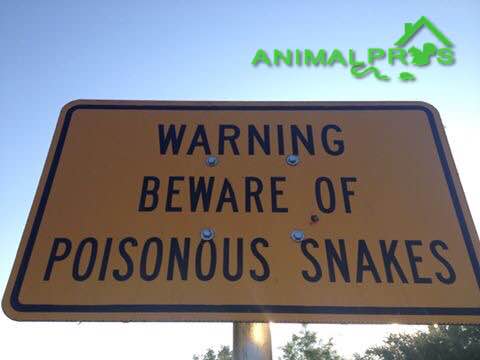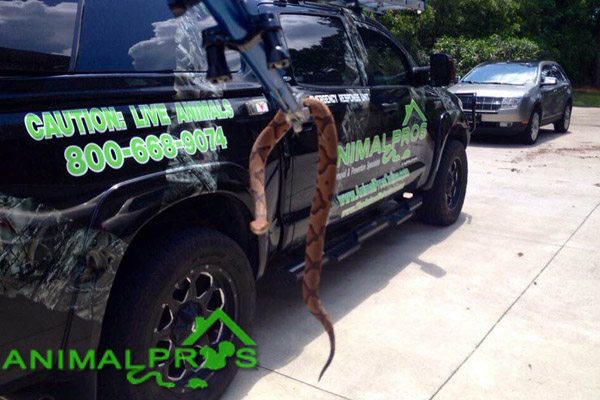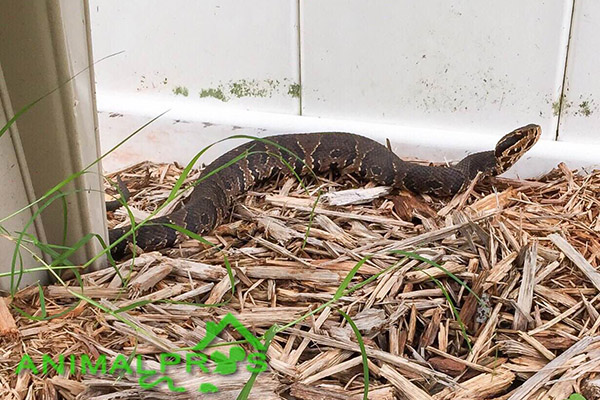Venomous Snakes in South Carolina
 There are 4 species of venomous snakes in South Carolina including the Timber Rattlesnake, Copperhead, Water Moccasin, and the Pigmy Rattlesnake.
There are 4 species of venomous snakes in South Carolina including the Timber Rattlesnake, Copperhead, Water Moccasin, and the Pigmy Rattlesnake.
All of South Carolina’s venomous snakes are pit vipers containing the heat seeking pit located between the eye and nostril.
While many snakes are mistaken for being venomous, they may resemble or mimic actions of a venomous snake.
Timber Rattlesnake (Crotalus horridus)

Timber Rattlesnake
- Height: 2″-4″
- Length: 35″-60″
- Weight: 1-10 pounds
- Diet: Carnivorous, eating birds, rodents, and small animals.
- Breeding: July through August.
- Gestation: 90 Days.
- Reproduction: Live birth of 5-14 young late summer through early fall.
- Habitat: Dense wooded areas, limestone rocky areas, and open areas.
- Legal Status: Common in South Carolina, and illegal to harm, capture, or remove from the wild in South Carolina.
- Other Names: Canebrake rattlesnake, banded rattlesnake, yellow rattlesnake, and black rattlesnake.
- Interesting Facts: The timber rattlesnake will have anywhere from 20-30 dark brownish “V” shaped bands on its body. When a Timber rattlesnake sheds its skin, the skin will contain the same pattern. Every year a snake sheds a “button” segment is added to its rattle. Is the largest and most dangerous snake in South Carolina.
The Timber Rattlesnake or (Canebrake Rattlesnake) can on average grow between 35″ and 60″ long. Average weight of a Timber Rattlesnake can be between on average 1-3 lbs, with some large specimens reaching nearly 10lbs. They are usually active between March through October, but depending on geographical location and warmer temperatures, can still be active on winter days. Timber Rattlesnakes give birth between August through late September to live young and can have as many as 14 young. They ares capable of living in the wild 12 years to as many as 30 years, and typically will den up or congregate during winter. Typical food sources of the Timber Rattlesnake can consist of small mammals, including squirrels, birds, amphibians, and even other snakes. Usually shedding its skin every year a new rattle segment will grow, or button on its rattle. The venom of the Timber Rattlesnake is used to immobilize prey, but can be fatal to people if a untreated bite occurs. Venom of a rattlesnake stops blood from clotting, and can destroy tissue and organs. If you happen to be struck, seek medical attention immediately.
Copperhead (Agkistrodon contortrix)

Copperhead
Copperhead
- Height: 1″-3″
- Length: 24″-40″
- Weight: 1-3 pounds
- Diet: Carnivorous, eating birds, rodents, and small insects.
- Breeding: July through August.
- Gestation: 3-9 months.
- Reproduction: Live birth of 5-8 young late summer through early fall.
- Habitat: Tolerant of habitat disturbance, so lives in urban areas well.
- Legal Status: Common in South Carolina, and illegal to harm, capture, or remove from the wild in South Carolina.
- Other Names: Highland moccasin or Dry-land Moccasin, Southern Copperhead, American Copperhead, and Northern Copperhead.
- Interesting Facts: In South Carolina, most snake bites occur from a copperhead. Most copperhead bites are a “dry” bite, with little to no venom. Juvenile copperheads have a bright yellow tail, to mimic a small worm to lure small insects, rodents, and amphibians closer.
Copperheads are well known from their copper appearance and colorations, as well as being the most responsible for occurring snake bites. Most bites occur when the snake is stepped on or near, and may be a dry bite where very little to no venom is injected. Copperheads are around Middle South Carolina. Most bites are a reaction strike, and Copperheads will not hesitate to strike. Their copper patterns can make them incredibly hard to spot among leaves as they blend right in. Adults can measure 2-3 ft, as some can be longer. They are usually active between February – October, and mating occurs between February to May and again in late fall from August to October. Copperheads can have between 2-18 young usually a grayer color. Young Copperheads are born with a bright yellow tail, and as they lay motionless, can flick the tail giving off the apperance of a caterpillar (Caudal Luring) for a unsuspecting lizard or frog. Copperheads can live as many as 20 years in the wild.
Water Moccasin (Agkistrodon piscivorus)

Water Moccasin
Water Moccasin
- Height: 2″-4″
- Length: 30″-60″
- Weight: 2-10 pounds
- Diet: Carnivorous, eating birds, rodents, fish, and small animals.
- Breeding: Can occur anytime throughout the year but typically April – May.
- Gestation: 3 to 4 Months.
- Reproduction: 8 – 12 young late summer through early fall..
- Habitat: Freshwater streams, ponds, rivers, lakes, and marshes.
- Legal Status: Common in South Carolina, and illegal to harm, capture, or remove from the wild in South Carolina.
- Other Names: Cottonmouth, swamp moccasin, black moccasin, and marsh moccasin.
- Interesting Facts: The Water Moccasin gets its name “Cottonmouth” from the white appearance of the inside of its mouth it shows to a perceived threat. Water moccasins can live over 20 years in the wild. They have been known to aggressively chase people.
The Water Moccasin or (Cottonmouth) is widely known for its white mouth as it opens warning someone that they are too close and it will bite. Water Moccasins typically range between 31″ to 70″ in length, and can weigh up to 10lbs. Although coloration may be totally black, they can range in colors from tan, olive, brown, yellowish, or grey patterns. Water Moccasins are the most aquatic venomous snake often being found near or close to water. They give birth to live young and can range from 1 to as many as 20 young during August through October, although mating can occur during any of the warmer months. They mostly feed on fish, reptiles, amphibians, small mammals, birds, and will feed on other snakes, even their own kind. Water Moccasins can be active almost year round, as they are the last snake species to den up in winter. They also happen to have the reputation for being the most aggressive.
Pigmy Rattlesnake (Sistrurus millarius)

Pygmy Rattlesnake
Pygmy Rattlesnake
- Height: 1″-2″
- Length: 15″-25″
- Weight: 1-2 pounds
- Diet: Carnivorous, eating small amphibians, rodents, and insects.
- Breeding: Occurs September – October.
- Gestation: 10 – 11 months.
- Reproduction: 4-7 young born in August.
- Habitat: Variety of habitats including pine forests, open ares, wooded areas, close to water sources.
- Legal Status: In certain areas of South Carolina, and illegal to harm, capture, or remove from the wild in South Carolina. It is listed as threatened by the TWRA, and imperiled by South Carolina Department of Environment and conservation.
- Other Names: Western Pigmy Rattlesnake, Dusky Pigmy Rattlesnake, Ground Rattlesnake, and Strecker’s Pigmy Rattlesnake.
- Interesting Facts: The pigmy rattlesnakes rattle can lightly be heard from 3 ft away. Juvenile pigmy rattlesnakes have a yellow tipped tail, to mimic a worm, to lure small rodents and amphibians for a closer look.
The Pigmy Rattlesnake has a very small rattle compared to other rattlesnakes which can seldomly be heard and it blends in with ground cover exceptionally well. They only average between 14″ an 30″ in length. They are active March through October and can give live birth to 3-8 young.
Preferred foods of the Pygmy tend to be lizards, frogs, and small rodents. Do not let their size fool you. They will act much larger and can be aggressive. With heat sensory pits it allows the snake to detect and accurately strike warm bodied prey.
